
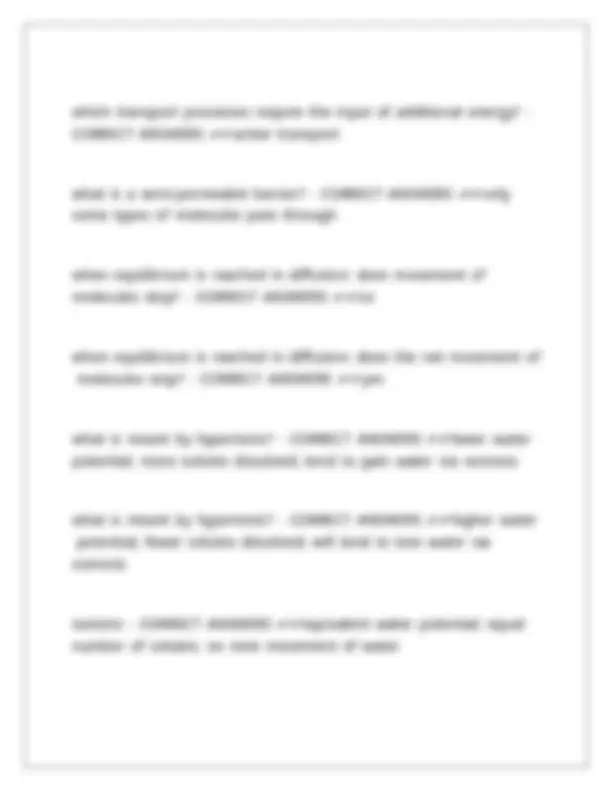
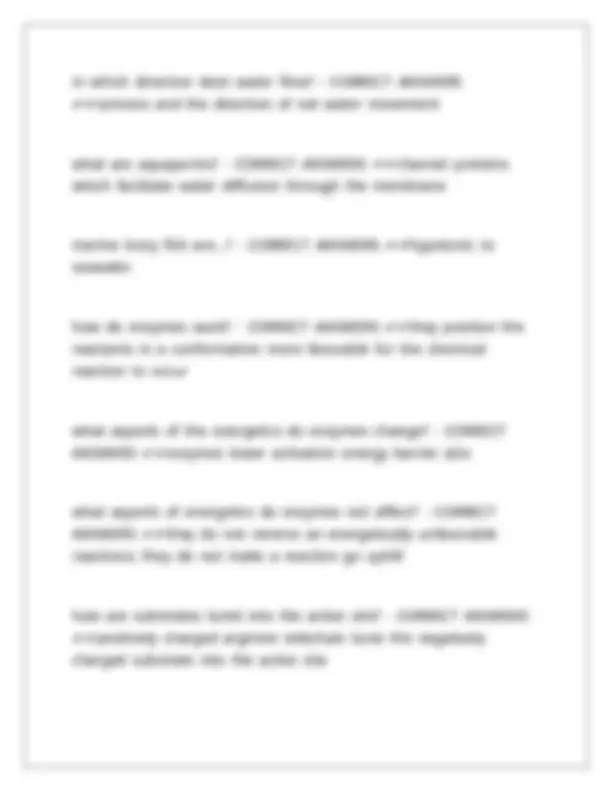
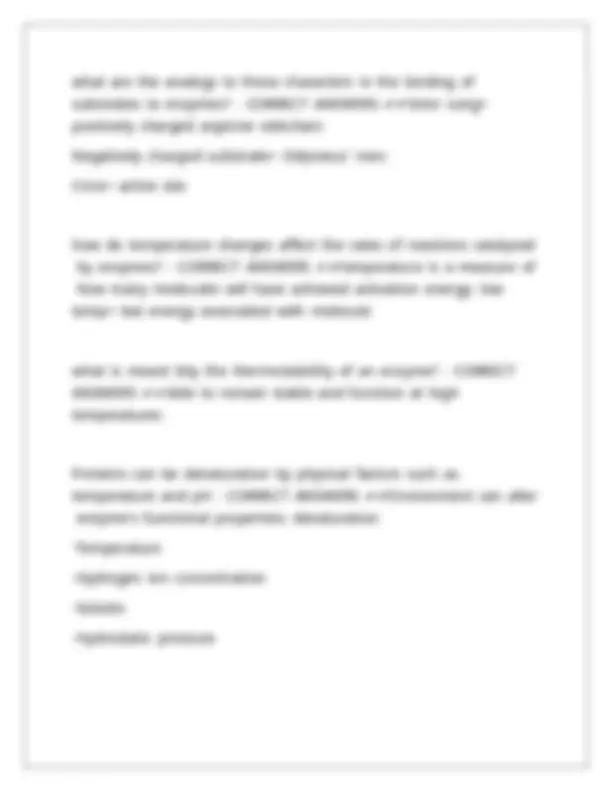
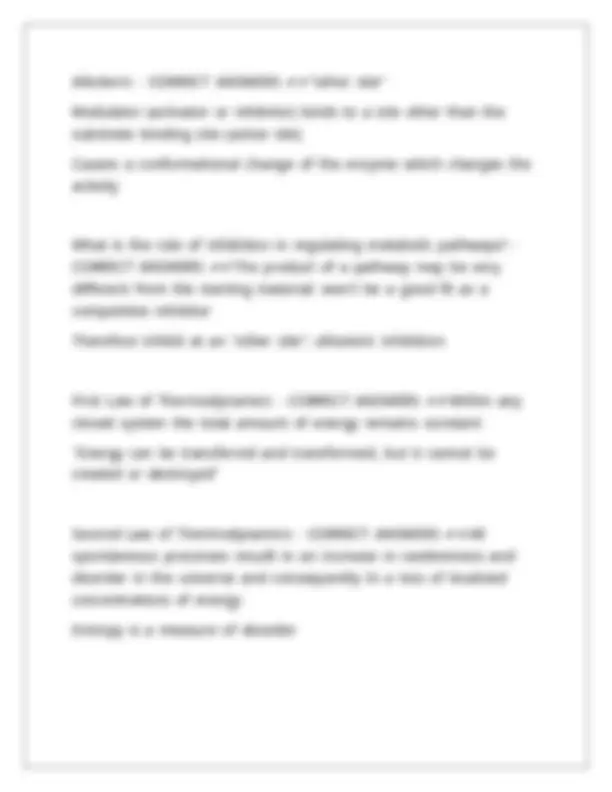
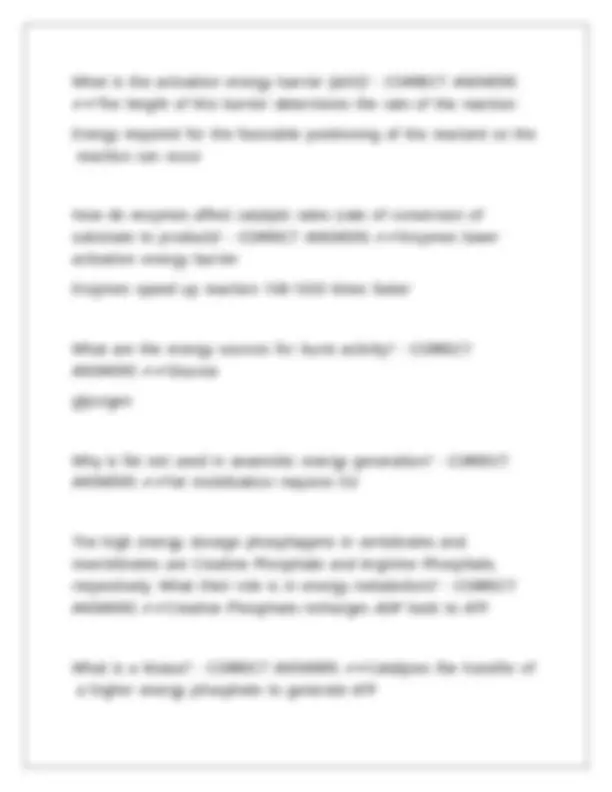
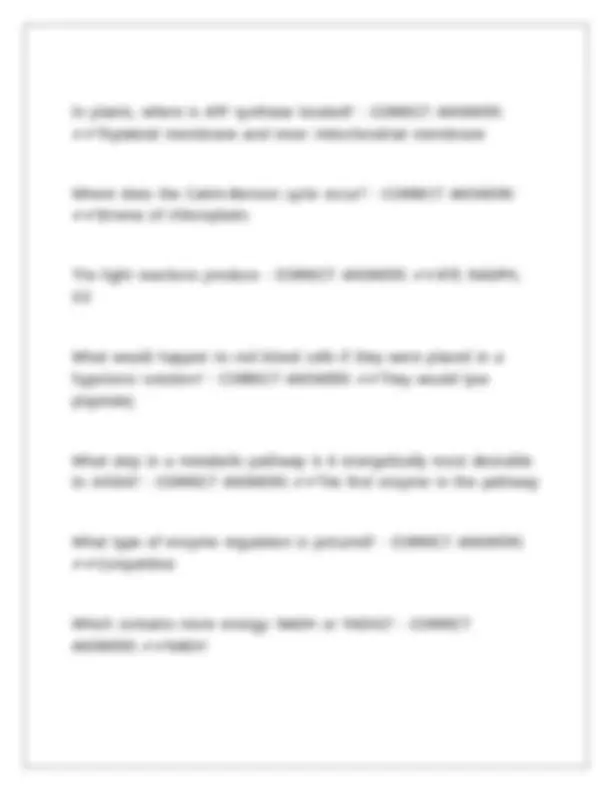
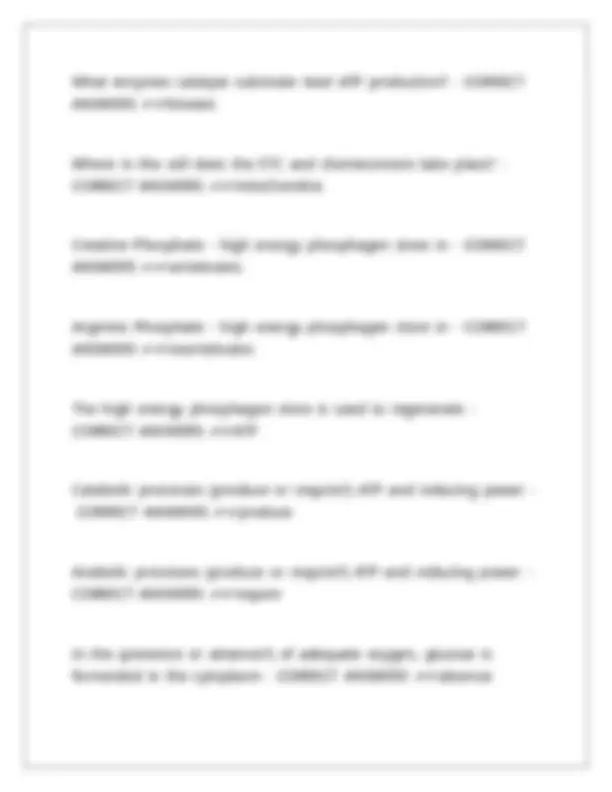
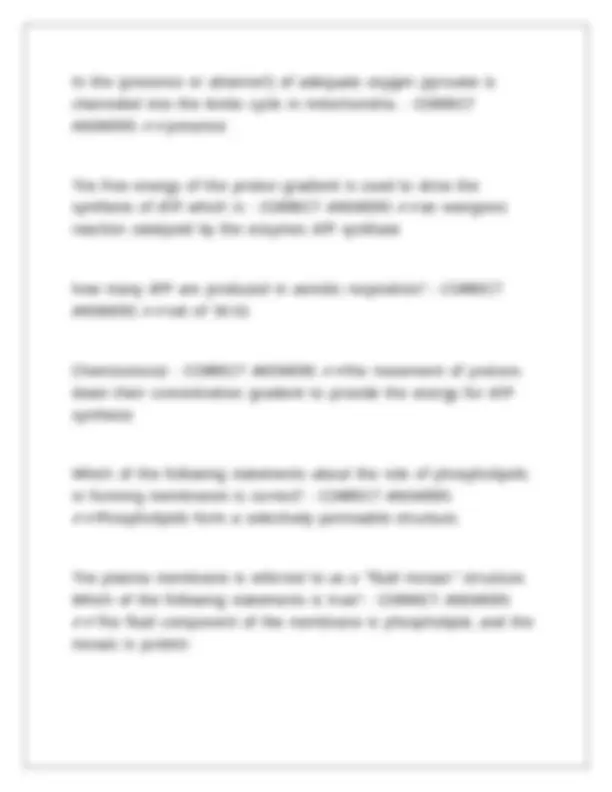
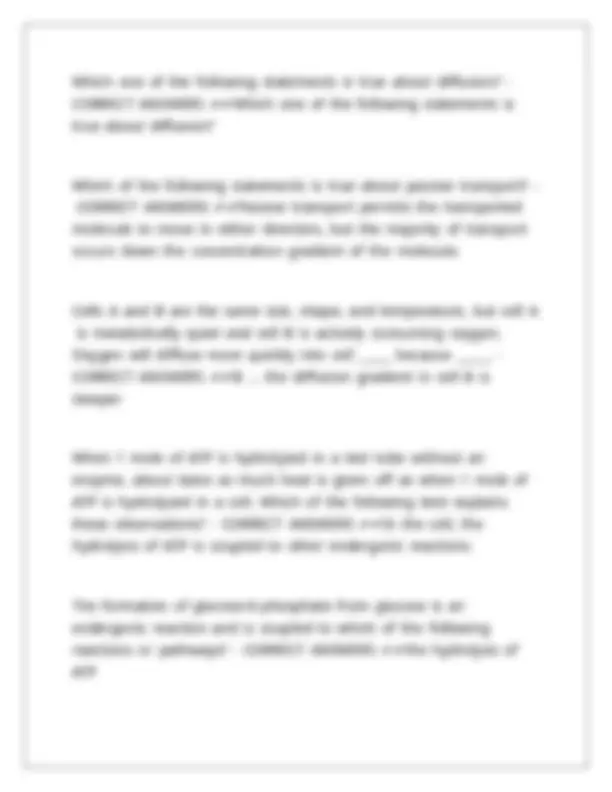
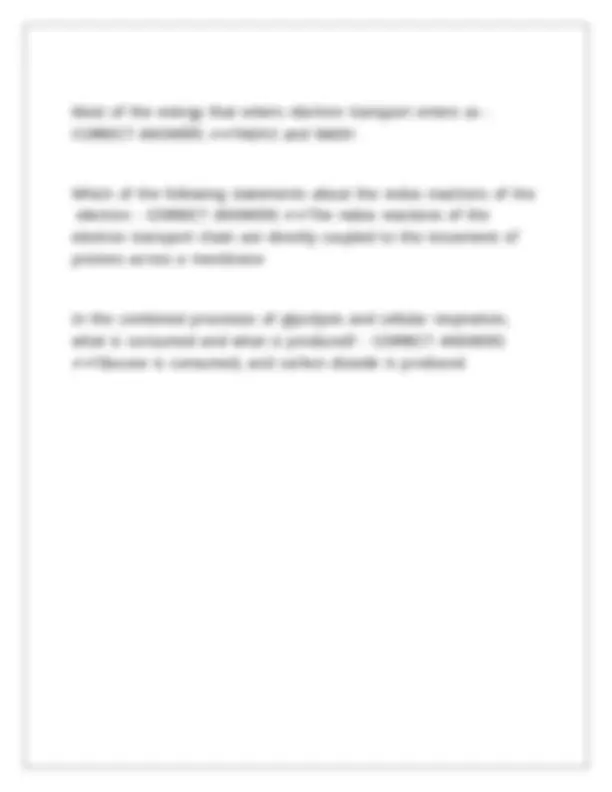


Study with the several resources on Docsity

Earn points by helping other students or get them with a premium plan


Prepare for your exams
Study with the several resources on Docsity

Earn points to download
Earn points by helping other students or get them with a premium plan
Community
Ask the community for help and clear up your study doubts
Discover the best universities in your country according to Docsity users
Free resources
Download our free guides on studying techniques, anxiety management strategies, and thesis advice from Docsity tutors
LSU Bio 1201 exam 2 questions with answers
Typology: Exams
1 / 18

This page cannot be seen from the preview
Don't miss anything!











why |\are |\membranes |\called |\phospholipid |\bilayers? |- |\CORRECT |
ANSWERS |\✔✔phospholipids |\have |\hydrophilic |\head |\and |\hydrophobic |\tail, |\hydrophobic |\face |\inside |\of |\cell |\making |\ 2 |\layers what |\is |\meant |\by |\fluid |\mosaic? |- |\CORRECT |\ANSWERS |\✔✔Mosaic |\of |
proteins |\drifting |\laterally |\in |\fluid |\bilayer |\of |\phospholipids how |\are |\membranes |\adjusted |\for |\different |\temperatures? |- |
CORRECT |\ANSWERS |\✔✔membrane |\fluidity |\adjusted |\by |\changing |\the |\ratio |\of |\unsaturated |\to |\saturated |\fatty |\acids how |\do |\the |\relative |\amounts |\of |\saturated |\and |\unsaturated |\fats |
change? |- |\CORRECT |\ANSWERS |\✔✔if |\you |\are |\in |\a |\cold |\environment |
you |\want |\more |\saturated |\fats |\for |\your |\membranes |\to |\be |\fluid; |
warm |\environment |\you |\want |\more |\saturated |\fats |\to |\make |\your |
membranes |\more |\solid what |\is |\meant |\by |\membrane |\fluidity? |- |\CORRECT |\ANSWERS |\✔✔not |
too |\solid, |\not |\too |\fluid why |\is |\fluidity |\an |\important |\property? |- |\CORRECT |\ANSWERS |
✔✔preserves |\membrane |\function
Henrique |\and |\Hanson |\performed |\experiments |\with |\pigs |\and |
examined |\the |\effects |\on |\the |\relative |\amounts |\of |\saturated |\and |
unsaturated |\fats. |\What |\did |\they |\find? |- |\CORRECT |\ANSWERS |
✔✔found |\that |\membrane |\fluidity |\can |\acclimate |\to |\temperature; |\pigs |\raised |\wearing |\underwear |\in |\a |\hot |\room |\had |\subcutaneous |\fats |
with |\higher |\melting |\point what |\types |\of |\molecules |\can |\move |\easily |\across |\the |\membrane? |- |
CORRECT |\ANSWERS |\✔✔small |\nonpolar |\molecules, |\gases, |\steroid |
hormones, |\and |\water what |\is |\simple |\diffusion? |- |\CORRECT |\ANSWERS |\✔✔down |\the |
concentration |\gradient; |\does |\not |\require |\supplied |\energy; |\does |\not |
use |\a |\carrier |\molecule what |\is |\facilitated |\diffusion? |- |\CORRECT |\ANSWERS |\✔✔down |\the |
concentration |\gradient; |\employs |\carrier |\molecule; |\does |\not |\require |
supplied |\energy what |\is |\active |\transport? |- |\CORRECT |\ANSWERS |\✔✔work |\must |\me |
done; |\must |\use |\supplied |\energy; |\employs |\carrier |\molecule for |\which |\transport |\processes |\are |\carrier |\molecules |\involved? |- |
CORRECT |\ANSWERS |\✔✔facilitated |\diffusion |\and |\active |\transport
in |\which |\direction |\does |\water |\flow? |- |\CORRECT |\ANSWERS |
✔✔osmosis |\and |\the |\direction |\of |\net |\water |\movement what |\are |\aquaporins? |- |\CORRECT |\ANSWERS |\✔✔channel |\proteins |
which |\facilitate |\water |\diffusion |\through |\the |\membrane marine |\bony |\fish |\are...? |- |\CORRECT |\ANSWERS |\✔✔hypotonic |\to |
seawater how |\do |\enzymes |\work? |- |\CORRECT |\ANSWERS |\✔✔they |\position |\the |
reactants |\in |\a |\conformation |\more |\favorable |\for |\the |\chemical |
reaction |\to |\occur what |\aspects |\of |\the |\energetics |\do |\enzymes |\change? |- |\CORRECT |
ANSWERS |\✔✔enzymes |\lower |\activation |\energy |\barrier |\ΔG⧧ what |\aspects |\of |\energetics |\do |\enzymes |\not |\affect? |- |\CORRECT |
ANSWERS |\✔✔they |\do |\not |\reverse |\an |\energetically |\unfavorable |
reactions; |\they |\do |\not |\make |\a |\reaction |\go |\uphill how |\are |\substrates |\lured |\into |\the |\active |\site? |- |\CORRECT |\ANSWERS |
✔✔positively |\charged |\arginine |\sidechain |\lures |\the |\negatively |
charged |\substrate |\into |\the |\active |\site
what |\are |\the |\analogs |\to |\these |\characters |\in |\the |\binding |\of |
substrates |\to |\enzymes? |- |\CORRECT |\ANSWERS |\✔✔Siren |\song= |
positively |\charged |\arginine |\sidechain Negatively |\charged |\substrate= |\Odysseus' |\men Circe= |\active |\site how |\do |\temperature |\changes |\affect |\the |\rates |\of |\reactions |\catalyzed |\by |\enzymes? |- |\CORRECT |\ANSWERS |\✔✔temperature |\is |\a |\measure |\of |\how |\many |\molecules |\will |\have |\achieved |\activation |\energy; |\low |
temp= |\low |\energy |\associated |\with |\molecule what |\is |\meant |\bby |\the |\thermostability |\of |\an |\enzyme? |- |\CORRECT |
ANSWERS |\✔✔Able |\to |\remain |\stable |\and |\function |\at |\high |
temperatures Proteins |\can |\be |\denaturation |\by |\physical |\factors |\such |\as |
temperature |\and |\pH |- |\CORRECT |\ANSWERS |\✔✔Environment |\can |\alter |\enzyme's |\functional |\properties: |\denaturation -Temperature -Hydrogen |\ion |\concentration -Solutes |
-Hydrostatic |\pressure
NADP |(oxidized |\form) NADPH |(reduced |\form) |
FAD+ FADH What |\do |\we |\mean |\by |"reducing |\power?" |- |\CORRECT |\ANSWERS |
✔✔The |\addition |\of |\electrons |\or |\hydrogen |\to |\a |\molecule |(adds |
energy) Oxidation= |\the |\removal |\of |\electrons |\or |\hydrogen |\from |\a |\molecule |
(reduces |\energy) |
|\There |\is |\a |\constant |\pool |\cycling |\between |\the |\reduced |\and |\oxidized |\forms. Competitive |\enzyme |\inhibition |- |\CORRECT |\ANSWERS |\✔✔Substrate |
and |\inhibitor |\compete |\for |\binding |\ot |\the |\active |\site |\of |\the |\enzyme Inhibitor |\is |\structurally |\similar |\to |\the |\substrate Most |\apparent |\at |\low |[substrate] Noncompetitive |\enzyme |\inhibition |- |\CORRECT |\ANSWERS |\✔✔Inhibitor |\binds |\at |\a |\site |\away |\from |\the |\substrate |\binding |\site Causes |\a |\conformational |\change |\in |\the |\enzyme Not |\overcome |\by |\increasing |\the |[substrate]
Allosteric |- |\CORRECT |\ANSWERS |\✔✔"other |\site" Modulator |(activator |\or |\inhibitor) |\binds |\to |\a |\site |\other |\than |\the |
substrate |\binding |\site |(active |\site) Causes |\a |\conformational |\change |\of |\the |\enzyme |\which |\changes |\the |
activity What |\is |\the |\role |\of |\inhibition |\in |\regulating |\metabolic |\pathways? |- |
CORRECT |\ANSWERS |\✔✔The |\product |\of |\a |\pathway |\may |\be |\very |
different |\from |\the |\starting |\material: |\won't |\be |\a |\good |\fit |\as |\a |
competitive |\inhibitor Therefore |\inhibit |\at |\an |"other |\site": |\allosteric |\inhibition First |\Law |\of |\Thermodynamics |- |\CORRECT |\ANSWERS |\✔✔Within |\any |
closed |\system |\the |\total |\amount |\of |\energy |\remains |\constant "Energy |\can |\be |\transferred |\and |\transformed, |\but |\it |\cannot |\be |
created |\or |\destroyed" Second |\Law |\of |\Thermodynamics |- |\CORRECT |\ANSWERS |\✔✔All |
spontaneous |\processes |\resuilt |\in |\an |\increase |\in |\randomness |\and |
disorder |\in |\the |\universe |\and |\consequently |\In |\a |\loss |\of |\localized |
concentrations |\of |\energy Entropy |\is |\a |\measure |\of |\disorder
In |\plants, |\where |\is |\ATP |\synthase |\located? |- |\CORRECT |\ANSWERS |
✔✔Thylakoid |\membrane |\and |\inner |\mitochondrial |\membrane Where |\does |\the |\Calvin-Benson |\cycle |\occur? |- |\CORRECT |\ANSWERS |
✔✔Stroma |\of |\chloroplasts The |\light |\reactions |\produce |- |\CORRECT |\ANSWERS |\✔✔ATP, |\NADPH, |
O What |\would |\happen |\to |\red |\blood |\cells |\if |\they |\were |\placed |\in |\a |
hypotonic |\solution? |- |\CORRECT |\ANSWERS |\✔✔They |\would |\lyse |
(explode) What |\step |\in |\a |\metabolic |\pathway |\is |\it |\energetically |\most |\desirable |
to |\inhibit? |- |\CORRECT |\ANSWERS |\✔✔The |\first |\enzyme |\in |\the |\pathway What |\type |\of |\enzyme |\regulation |\is |\pictured? |- |\CORRECT |\ANSWERS |
✔✔Competitive Which |\contains |\more |\energy: |\NADH |\or |\FADH2? |- |\CORRECT |
ANSWERS |\✔✔NADH
Which |\contains |\more |\energy: |\Glucose |\or |\pyruvate? |- |\CORRECT |
ANSWERS |\✔✔Glucose O2 |\is |\used |\by |- |\CORRECT |\ANSWERS |\✔✔Oxidative |\phosphorylation O2 |\is |\produced |\by |- |\CORRECT |\ANSWERS |\✔✔Light |\reactions Water |\is |\split |\in |- |\CORRECT |\ANSWERS |\✔✔Light |\reactions Autotroph |- |\CORRECT |\ANSWERS |\✔✔An |\organism |\that |\obtains |
organic |\molecules |\without |\eating |\other |\organisms Heterotroph |- |\CORRECT |\ANSWERS |\✔✔An |\organism |\that |\obtains |
organic |\molecules |\by |\eating |\other |\organisms An |\endergonic |\reaction |\has |\negative |\or |\positive |\ΔG? |- |\CORRECT |
ANSWERS |\✔✔Positive |(+ |\ΔG) What |\is |\ΔG‡? |- |\CORRECT |\ANSWERS |\✔✔Activation |\energy |\barrier; |
determines |\the |\rate |\of |\the |\reaction Is |\a |\reaction |\with |- |\ΔG |\spontaneous? |- |\CORRECT |\ANSWERS |\✔✔yes
What |\enzymes |\catalyze |\substrate |\level |\ATP |\production? |- |\CORRECT |
ANSWERS |\✔✔Kinases Where |\in |\the |\cell |\does |\the |\ETC |\and |\chemiosmosis |\take |\place? |- |
CORRECT |\ANSWERS |\✔✔mitochondria Creatine |\Phosphate |- |\high |\energy |\phosphagen |\store |\in |- |\CORRECT |
ANSWERS |\✔✔vertebrates Arginine |\Phosphate |- |\high |\energy |\phosphagen |\store |\in |- |\CORRECT |
ANSWERS |\✔✔invertebrates The |\high |\energy |\phosphagen |\store |\is |\used |\to |\regenerate |- |
CORRECT |\ANSWERS |\✔✔ATP Catabolic |\processes |(produce |\or |\require?) |\ATP |\and |\reducing |\power |- |\CORRECT |\ANSWERS |\✔✔produce Anabolic |\processes |(produce |\or |\require?) |\ATP |\and |\reducing |\power |- |
CORRECT |\ANSWERS |\✔✔require In |\the |(presence |\or |\absence?) |\of |\adequate |\oxygen, |\glucose |\is |
fermented |\in |\the |\cytoplasm |- |\CORRECT |\ANSWERS |\✔✔absence
In |\the |(presence |\or |\absence?) |\of |\adequate |\oxygen |\pyruvate |\is |
channeled |\into |\the |\Krebs |\cycle |\in |\mitochondria. |- |\CORRECT |
ANSWERS |\✔✔presence The |\free |\energy |\of |\the |\proton |\gradient |\is |\used |\to |\drive |\the |
synthesis |\of |\ATP |\which |\is |- |\CORRECT |\ANSWERS |\✔✔an |\exergonic |
reaction |\catalyzed |\by |\the |\enzymes |\ATP |\synthase how |\many |\ATP |\are |\produced |\in |\aerobic |\respiration? |- |\CORRECT |
ANSWERS |\✔✔net |\of |\30- Chemiosmosis |- |\CORRECT |\ANSWERS |\✔✔the |\movement |\of |\protons |
down |\their |\concentration |\gradient |\to |\provide |\the |\energy |\for |\ATP |
synthesis Which |\of |\the |\following |\statements |\about |\the |\role |\of |\phospholipids |
in |\forming |\membranes |\is |\correct? |- |\CORRECT |\ANSWERS |
✔✔Phospholipids |\form |\a |\selectively |\permeable |\structure. The |\plasma |\membrane |\is |\referred |\to |\as |\a |"fluid |\mosaic" |\structure. |
Which |\of |\the |\following |\statements |\is |\true? |- |\CORRECT |\ANSWERS |
✔✔The |\fluid |\component |\of |\the |\membrane |\is |\phospholipid, |\and |\the |
mosaic |\is |\protein
The |\mechanism |\of |\enzyme |\action |\is |_____. |- |\CORRECT |\ANSWERS |
✔✔lowering |\the |\energy |\of |\activation |\for |\a |\reaction A |\chemical |\reaction |\is |\designated |\as |\exergonic |\rather |\than |
endergonic |\when |_____ |- |\CORRECT |\ANSWERS |\✔✔the |\potential |
energy |\of |\the |\products |\is |\less |\than |\the |\potential |\energy |\of |\the |
reactants What |\best |\characterizes |\the |\role |\of |\ATP |\in |\cellular |\metabolism? |- |
CORRECT |\ANSWERS |\✔✔The |\free |\energy |\released |\by |\ATP |\hydrolysis |
may |\be |\coupled |\to |\an |\endergonic |\process |\via |\the |\formation |\of |\a |
phosphorylated |\intermediate. A |\chemical |\reaction |\is |\designated |\as |\endergonic |\rather |\than |
exergonic |\when |_____. |- |\CORRECT |\ANSWERS |\✔✔the |\potential |\energy |\of |\the |\reactants |\is |\less |\than |\the |\potential |\energy |\of |\the |\products Which |\of |\the |\following |\statements |\about |\enzymes |\is |\true? |- |
CORRECT |\ANSWERS |\✔✔Enzymes |\speed |\up |\the |\rate |\of |\the |\reaction |
without |\changing |\the |\Delta |\G |\for |\the |\reaction. A |\glucose |\molecule |\is |\completely |\broken |\down |\to |\carbon |\dioxide |
and |\water |\in |\glycolysis |\and |\the |\citric |\acid |\cycle, |\but |\together |\these |
two |\processes |\yield |\only |\a |\few |\molecules |\of |\ATP. |\What |\happened |\to |\most |\of |\the |\energy |\that |\the |\cell |\obtains |\from |\the |\oxidation |\of |
glucose? |- |\CORRECT |\ANSWERS |\✔✔It |\is |\stored |\in |\NADH.
In |\fermentation, |________ |\is |________. |- |\CORRECT |\ANSWERS |\✔✔NADH; |\oxidized In |\the |\absence |\of |\oxygen, |\what |\is |\the |\net |\gain |\of |\ATP |\for |\each |
glucose |\molecule |\that |\enters |\glycolysis? |- |\CORRECT |\ANSWERS |\✔✔ 2 |
ATP Pyruvate |\is |\formed |- |\CORRECT |\ANSWERS |\✔✔in |\the |\cytosol Glycolysis |\is |\an |________ |\reaction |- |\CORRECT |\ANSWERS |\✔✔exergonic How |\many |\ATP |\molecules |\are |\produced |(total) |\by |\glycolysis? |- |
CORRECT |\ANSWERS |\✔✔ 4 Which |\statement |\about |\the |\citric |\acid |\cycle |\is |\incorrect? |- |\CORRECT |
ANSWERS |\✔✔The |\oxidation |\of |\compounds |\by |\the |\citric |\acid |\cycle |
requires |\molecular |\oxygen Cells |\do |\not |\catabolize |\carbon |\dioxide |\because |- |\CORRECT |
ANSWERS |\✔✔CO2 |\is |\already |\completely |\oxidized Most |\CO2 |\from |\catabolism |\is |\released |\during |- |\CORRECT |\ANSWERS |
✔✔the |\citric |\acid |\cycle